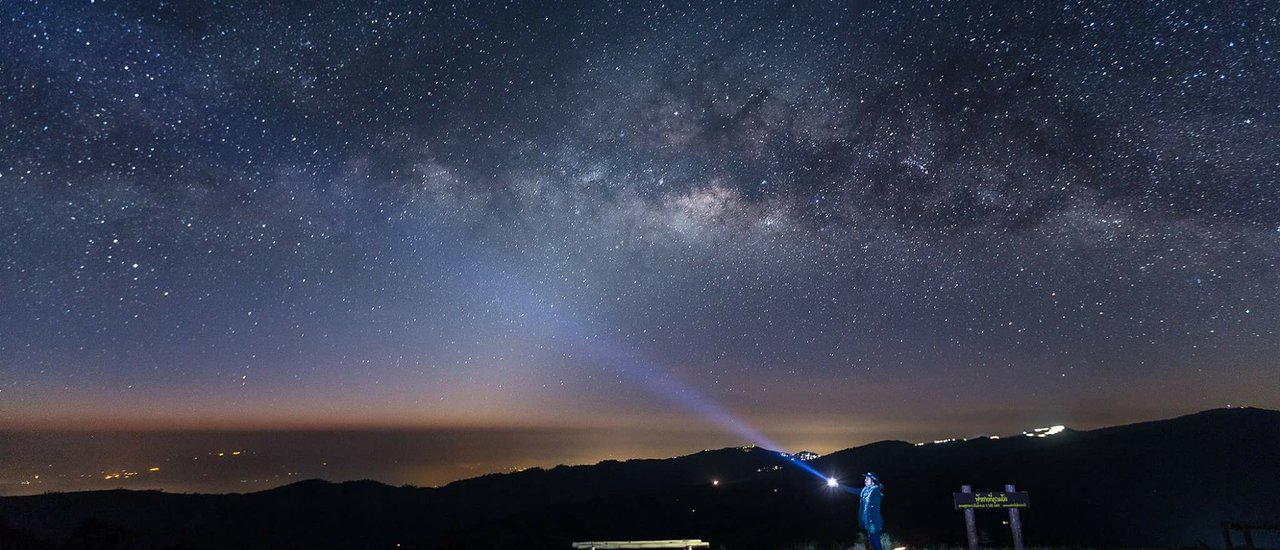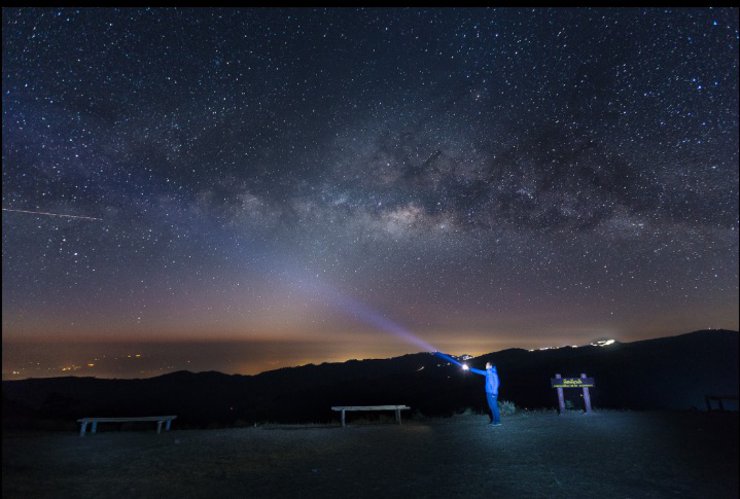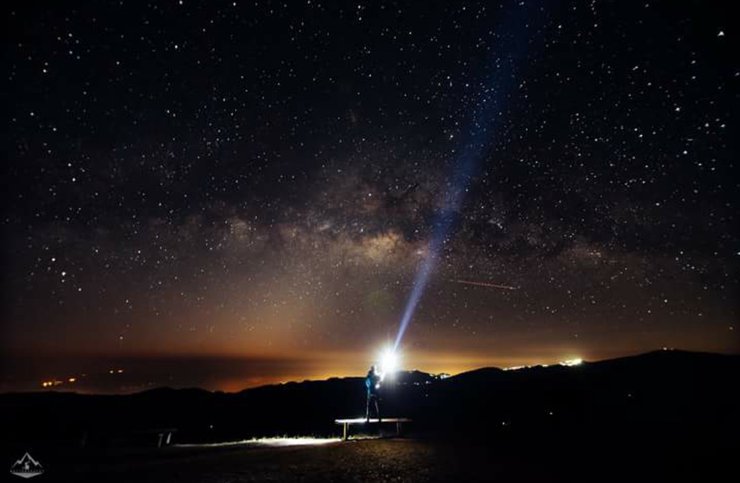Good morning, early risers! Today, we have a 4 am appointment (again!) to go elephant hunting (photographing the Milky Way). Our destination is the summit of Phu Lom Lo. We will be traveling in the same pickup truck as before, so it is essential to bring masks, hats, and sunglasses. The team leaders also mentioned that the weather at the top will be cold and windy, so don't forget to pack warm clothes. The road to the summit is a bumpy dirt track, and the ride takes about an hour. The area at the top is open and pitch black, allowing us to see the stars clearly and even the Milky Way with our naked eyes. It was truly a breathtaking sight.

Source: Uncle Redee, AOST.

Crystallography

Cr. Uncle Thawee, A.S.T.
This is a scene that city dwellers like us would never see. The photographers told us that the Milky Way is always there, but we can only see it on days with clear skies and in very dark places. In a city like Bangkok, with its high levels of pollution and constant bright lights, it's impossible to see. It's a bit disheartening to hear that in places with the most development, natural beauty is gradually diminishing.
The elephant capture mission was successfully completed, and soon the sun began to rise, greeting the new day.


As the sun rises, casting its warmth and light upon the land, the darkness and chill of the night recede. Hunger pangs begin to gnaw at our empty stomachs, prompting us to seek sustenance. We make our way to a scenic viewpoint, where we can enjoy a delightful breakfast amidst the breathtaking surroundings.

Sticky rice with pork and chili paste is perfect for this kind of atmosphere. The team also brought hot water to make coffee and cocoa. They took such good care of us, I'm really impressed.
After a satisfying meal, we continued to explore the area, only to be met with an abundance of signs. This left us with a somewhat underwhelming impression. While the scenery was undeniably breathtaking, it was significantly obscured by the numerous signs, the purpose of which remained unclear. Perhaps it was driven by cultural norms or other factors, but we couldn't help but feel that it created a cluttered and visually overwhelming experience.

This location not only offers picturesque photo opportunities but also provides clean and secure restrooms. However, be prepared for refreshingly cold water.
While strolling and enjoying the scenery, we stumbled upon a patch of vegetation that closely resembled the edible fern known as "phak kood". We discussed the possibility of collecting it for a stir-fry, reminiscing about the delicious "phak kood" stir-fry we had enjoyed the previous day. However, our culinary dreams were dashed when a friend informed us, "Even cows and buffaloes wouldn't touch this plant." We were left speechless and walked away, chuckling at our near miss. 😅😅 Upon further inquiry, we learned that the vegetation we had encountered was indeed "phak kood", but a different variety from the edible one. The edible variety, known as "phak kood nam", grows near water sources, while the inedible variety, "phak kood pa", is found in forests.
From the viewpoint, we took a short drive back to take pictures on a large rock. With the right angle, the photos will look like we are standing on a cliff, even though the rock is actually less than 2 meters high from the ground.




After taking photos to our heart's content, it was time for the highlight of the day: the field of Wild Himalayan Cherry blossoms, also known as the "Thai sakura".
Upon arrival, we realized we were too late. The flowers had begun to wilt and fade. The vibrant pink hues we had seen in the pictures were nowhere to be found.

Local villagers informed us that the optimal time to view the flowers is during the third week of January. Although we were unable to witness them in full bloom during our visit, we persisted in capturing as many stunning photographs as possible for your enjoyment.

What's the point of our efforts? We've been craning our necks until we're sore... And this is what we get?


Despite taking hundreds of photos, only a few are usable. 😭😭😭 However, the local villager who drove us up the mountain was incredibly kind. He overheard us complaining and went to find a beautiful tree for us. When he found it, he called us over. I thought it was nearby, but as we started walking, I began to struggle because the path was constantly uphill. When we finally arrived, the tree was covered in beautiful pink flowers, but it was the only one there. 😩😩😩 We had walked so far and were exhausted, even lifting our phones to take photos was difficult. Despite our efforts, none of the photos turned out well. 😭😭😭 After admiring the flowers and trees, we returned to our accommodation to shower and pack our belongings.
Following our previous activity, do you recall the ginger we unearthed in episode one? We will now transform it. However, before we begin, let's refuel ourselves. Lunch will be served at the same location where we will be engaging in our activity.
Today's meal is a local dish and a specialty of this community.

Let's start with the fermented papaya salad, which is only available here. The taste is sour and sweet, and you hardly need to add any seasoning. The fermented juice alone is enough to make it delicious. Then there's the shredded banana flower salad, which is packed with ingredients. If you like sweet and creamy flavors, you'll definitely love this dish. The chicken curry is also delicious. The taste is similar to a northern Thai curry, but it seems to have been simmered for a while because the chicken is very tender and easy to eat. Last but not least, the fermented pork sausage and omelet helped to save us from the spiciness. Actually, there was also a dessert of boiled taro in coconut milk, but I didn't get to take a picture of it because it was gone so quickly. I give this meal a 10 out of 10, it was amazing.
With full stomachs, we continued with our activities. As mentioned before the meal, we would be processing ginger, transforming fresh ginger into ginger powder.
The process begins by thoroughly washing the ginger, peeling it, and slicing it into segments. These segments are then blended with boiled water, and the mixture is strained to extract the ginger juice. The ginger juice is then combined with sugar in a pan and simmered continuously until the ginger juice transforms into a powder.


After 45 minutes, we finally succeeded in making ginger powder. My mother said that we still need to grind it to make it fine and delicious.

The process of transforming ginger into powder for consumption requires immense patience, expertise, and meticulous attention to detail.
It's time to say goodbye to the Kok Sathon community. Thank you to all the mothers and older siblings in the Kok Sathon community who took such good care of us. If we have the chance, we will definitely come back to visit again.
Thank you for the beautiful photos from Uncle Sai, Asat, Muztongraphy, and Brother Peen.
Ep.3 We will take you to visit another community that you must not miss...
Yuiyui Yookyik
Friday, October 4, 2024 3:18 PM



















